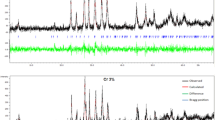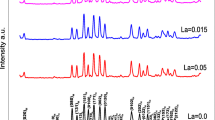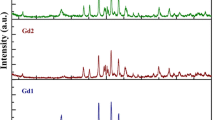Abstract
The structural and magnetic properties evolution of Cr-doped Bi2Sr2CaCu2−xCrxOy ceramics (x = 0.0, 0.05, 0.1, and 0.25) have been investigated using XRD, SEM, DC resistivity and M–H measurements. X-ray diffraction studies have shown that all samples are mainly composed of Bi-2212 phase, indicating that Cr can be incorporated in its crystal structure. The microstructure of the highly Cr-doped samples showed that some impurity phases appear, decreasing the conductivity between the grains. T c (onset) and T c (offset) have been improved for x = 0.05 Cr doping, while 0.25 Cr doped samples are not superconducting. This behavior can be associated to changes in the hole concentration and/or the magnetic nature of Cr. The magnetic properties indicate that low Cr-doping enhances the loop widths. Additionally, the critical current densities, J c , of samples have been calculated by using the Bean’s critical state model. It has been found that there are important improvements in J c values between 0.2 and 0.9 T applied magnetic fields for 0.05 Cr doped samples.
Similar content being viewed by others
Avoid common mistakes on your manuscript.
1 Introduction
The Bi–Sr–Ca–Cu–O superconductors family is formed by the well-known Bi-2201, Bi-2212, and Bi-2223. Among them, the Bi-2212 phase presents several advantages, as its high thermodynamic stability and easy formation. Moreover, it can be obtained as nearly single phase without the need of adding or substituting with other elements. However, the presence of intergrain weak links and the weak flux pinning capability in bulk materials are still drawbacks for reaching high critical current density (J c ) values in these materials [1, 2]. As it is well known, the enhancement of J c is one of the most important issues for their practical applications [3,4,5,6,7,8]. As a consequence, many attempts have been performed to increase their current carrying capability. Some of them have reached high J c ’s through solid-state techniques, such as high applied pressure [8]. On the other hand, directional solidification techniques, such as the Laser Floating Zone (LFZ) [9,10,11,12,13], or the electrically assisted laser floating zone (EALFZ) [14, 15] have produced high density samples with well oriented grains, dramatically raising electrical transport properties.
In particular, it has been reported that samples grown at 15 mm/h using the LFZ method provides the highest grain alignment without internal cracks [16, 17]. Moreover, these improvements can be further enhanced by using doping or wet chemistry preparation methods, which can affect the charge carrier density [18,19,20,21,22,23,24,25,26,27,28,29,30,31,32]. This is an important parameter, as it is well known that the superconducting properties are improved by increasing the hole concentration per Cu atom in the Cu-O planes [33]. However, when the optimal hole concentration is exceeded, it is possible to destroy superconductivity [34,35,36,37,38].
In this work, the effect of Cr doping on the properties of 15 mm/h LFZ grown Bi-2212 ceramics has been studied. Samples have been characterized using X-ray powder diffraction (XRD), scanning electron microscopy (SEM), DC electrical resistivity and magnetic-hysteresis loop measurements.
2 Materials and methods
Bi2Sr2CaCu2−xCrxOy ceramics, with x = 0.0, 0.05, 0.10, and 0.25, have been prepared through a polymer solution route from commercial Bi(CH3COO)3 (≥99.99%, Aldrich), Sr(CH3COO)2·1/2H2O (99%, Panreac), Ca(CH3COO)2·H2O (98%, Alfa Aesar), Cu(CH3COO)2·H2O (98%, Panreac), and Cr(CH3COO)·H2O (99.9%, Alfa Aesar) powders. They were weighed in the appropriate proportions, and dissolved in a mixture of glacial acetic acid and water. To the resulting clear blue solution, polyethyleneimine (PEI) (Aldrich, 50 wt% water) was added, turning to deep blue immediately. The solution was then concentrated by recovering about 70% of the initial solvent in a rotary evaporator. Total solvent evaporation is produced on a hot plate at about 150 °C, producing a deep blue thermoplastic paste. Further heating at about 300–350 °C decomposes the organic material through a selfcombustion, with the release of CO2 and nitrogen oxides. The brownish powder was then thermally treated at 750 and 800 °C for 12 h with an intermediate manual milling in order to decompose the alkaline-earth carbonates. The final black powders were isostatically pressed in form of cylinders (∼3 mm diameter) at about 200 MPa. The green ceramics were subsequently grown at 15 mm/h in a LFZ system using 18 rpm relative rotation between the seed and feed. Texturing conditions were selected according to previous works [39, 40].
Due to the incongruent melting of these materials, it is necessary to perform an annealing process to produce the Bi-2212 phase. It has been performed in two steps: 60 h at 860 °C to form the Bi-2212 phase, followed by 12 h at 800 °C to adjust the oxygen content and, finally, quenched in air to room temperature.
Samples with x = 0.0, 0.05, 0.1 and 0.25 will hereafter be named A, B, C and D, respectively.
Electrical resistivity and magnetic measurements were carried out using a Cryogenic Limited PPMS (from 5 to 300 K). X-ray powder diffraction analyses were performed in a Rigaku Ultima IV X-Ray Diffractometer with a constant scan rate (2°/min) in the range 2θ = 3–60° to identify the different phases. Lattice parameters have been automatically calculated by the PDXL software version 1.6.0.1 with the ICDD version 6.0 database. Microstructural characterization was made on polished longitudinal cross-sections of annealed samples, using a scanning electron microscope (SEM, JEOL JSM 6400) equipped with an energy dispersive spectroscopy (EDX) system.
3 Result and discussion
3.1 XRD characterization
Figure 1 shows the powder XRD patterns of all samples. As it can be observed in the figure, major phase is the high-T C Bi-2212 in all cases. Moreover, small amounts of Bi2CaO4 secondary phase have been detected (peaks indicated by * in the figure). Moreover, no Cr-based phases have been detected, suggesting that Cr has been incorporated into the Bi-2212 phase crystal structure. On the other hand, an increase in the XRD peaks intensity of B samples at 2θ = 24.98°, 27.7°, 31.24° and 45.04° can be observed, indicating that they possess higher crystallinity [41,42,43].
Lattice parameters calculated from the XRD diffraction data are displayed in Table 1. The increase of a and b unit cell parameters in the Cr-substituted samples, when compared with the undoped ones, can be due to Cr incorporation in Bi-2212 crystal structure. Other feature illustrated in Table 1 is the slight decrease of a, b, and c parameters in the C samples, compared with the ones with lower and higher Cr-doping. This is an unexpected result and more work should be performed in this system in order to clearly explain the crystalline parameters evolution.
3.2 SEM analysis
SEM micrographs performed on longitudinal polished sections of all samples are given in Fig. 2. In these images, it can be observed that there is a good alignment of grains along the growth direction. However, several contrasts can be seen in these samples. EDX analysis of these contrasts has allowed the identification of three different phases. Grey contrast (major one) corresponds to the superconducting Bi-2212 phase, while white and black contrasts to Bi-2201 and CaO secondary phases. These phases agree with the XRD data, with the exception of CaO, not detected with this technique, probably due to its low amount. Moreover, the amount of this secondary phase is decreased in samples B, compared with the A ones, while it increases again for higher Cr doping.
3.3 Electrical measurements
Figure 3 shows the temperature dependence of the electrical resistivity for A, B, and C samples. Due to the fact that D samples are not superconducting, their resistivity results have not been included in the figure. These results seem to disagree with the RXD results, which showed very similar patterns for all samples. On the other hand, it is well-known that the formula of this phase can be written as Bi2Sr2CaCu2O8 + δ. This δ coefficient indicates a slight excess of oxygen in the perovskite structure. Moreover, the superconducting properties are dramatically affected by relatively small δ value variations without modifying the crystal structure [44]. When observing the graph, T c (onset) of all these samples is higher than 90 K, typical values for the Bi-2212 phase. However, the width of the superconducting transition (ΔT c ) for x > 0.05 is considerably increased (see Table 2). This effect suggests that Cr is modifying the Bi-2212 oxygen content, affecting the superconducting properties. Moreover, another effect produced by Cr addition is the modification of Bi-2212 phase melting point. These variations lead to important changes in the grain boundaries, reflected in the T c (offset) values. It is obvious that grains connectivity is significantly decreased when Cr content is increased. On the other hand, as previously mentioned, the superconducting transition temperature depends on the charge carrier concentration. It is clear that high Cr-doping negatively affects the charge density between CuO2 and their adjacent charge reservoir layers. From these considerations and the above data, it can be observed that samples B are closer to the optimal charge carrier concentration than the other ones.
3.4 Magnetic properties
The magnetic-hysteresis cycles, between ± 1 T applied fields, for all the samples at 10 K, are presented in Fig. 4. M–H loops in conventional type II superconductors are extremely important in determining pinning forces as well as their diamagnetic characteristics [30, 45]. In the figure, it is evident that M R values, as well as the M–H loops width significantly decrease when Cr content is increased. These effects clearly point out to a pinning force decrease in the Cr-doped samples. However, the path of magnetic hysteresis curves is quite similar in all Cr-doped samples, implying the formation of similar phases. Even if electrical measurements for samples D showed that they were non superconducting, they display a magnetic hysteresis loop due to the presence of Bi-2212 phase. On the other hand, a clear difference in the shape of the hysteresis loops can be observed from the undoped to the Cr-doped samples. Furthermore, in spite of these modifications, sample B seems to possess larger loop area than the undoped ones, probably due to their higher Bi-2212 phase content.
The J C values for all samples were calculated from the hysteresis loops at 10 K, using the Bean’s model [46]:
where J c is the magnetization current density in ampéres per square centimeter. \(\Delta M\)= M + − M − is measured in electromagnetic units per cubic centimeter, and d is the sample thickness.
Figure 5 shows the calculated critical current densities for all samples, as a function of the applied field, at 10 K. It should be noted that resistivity results have shown that samples D are no superconducting. However, XRD results showed that samples D are majorly formed by the Bi-2212 phase, otherwise they would consist in a large halo [47]. Thus, even if calculated J c values of these samples do not reflect a real transport critical current density, they have been represented in Fig. 5. From the figure, it is clear that samples B have the highest critical current values between 0.2 and 0.9 T applied magnetic fields. These results clearly indicate the formation of stronger links between the grains in samples B, compared with the A ones. This effect can be explained taking into account that weak links can be enough to maintain the continuity of supercurrents under low magnetics. On the other hand, strong grain links are required under high magnetic fields [48, 49].
The highest J c values (14.65 × 104 A/cm2) under 0.9 T applied magnetic field have been obtained for samples B at 10 K, suggesting that low Cr doping favours the formation of strong links between grains.
4 Conclusions
The effect of Cr doping on Bi2Sr2CaCu2−xCrxOy phase (x = 0, 0.05, 0.10, and 0.25) has been investigated. A highest superconducting transition temperature has been found in the 0.05 Cr doped samples. Powder XRD results have revealed that all samples have similar patterns, with the Bi-2212 phase as the major one. However, the intensity of some XRD peaks for 0.05Cr-doped samples is higher than in the other ones, which can explain the observed enhancements in their T c values. Magnetization loops (M–H) results have clearly shown that the width of hysteresis loops increase in 0.05 Cr doped samples. As a consequence, it can be deduced that Cr doping in low contents is useful to raise the superconducting properties of Bi-2212.
References
Z.Y. Jia, H. Tang, Z.Q. Yang, Y.T. Xing, Y.Z. Wang, G.W. Qiao, Physica C 337, 130 (2000)
O. Bilgili, Y. Selamet, K. Kocabaş, J. Supercond. Nov. Magn. 21, 439 (2008)
B. Özkurt, M.A. Madre, A. Sotelo, J.C. Diez, Physica B 426, 85 (2013)
B. Özkurt, M.A. Madre, A. Sotelo, J.C. Diez, J. Supercond. Nov. Magn. 26, 3247 (2013)
M.E. Aytekin, B. Özkurt, İ. Sugözü, J. Mater. Sci. 26, 1799 (2015)
B. Ozcelik, B. Ozkurt, M. E. Yakinci, A. Sotelo, M. A. Madre, J. Supercond. Nov. Magn. 26, 873 (2013)
M.E. Aytekin, B. Özkurt, K.B. Sugözü, E. Kose, İ. Sugözü, J. Mater. Sci. 27, 8068 (2016)
D. Marconi, C. Lung, A.V. Pop, J. Alloys Comp. 579, 355 (2013)
Y. Huang, G.F. de la Fuente, A. Sotelo, A. Badia, F. Lera, R. Navarro, C. Rillo, R. Ibanez, D. Beltran, F. Sapina, A. Beltran, Physica C 185, 2401 (1991)
R.S. Feigelson, D. Gazit, D.K. Fork, T.H. Geballe, Science 240, 1672 (1988)
M. Mora, A. Sotelo, H. Amaveda, M.A. Madre, J.C. Diez, F. Capel, J.M. Lopez-Cepero, J. Eur. Ceram. Soc. 27, 3959 (2007)
G.F. de la Fuente, M.T. Ruiz, A. Sotelo, A. Larrea, R. Navarro, Mater. Sci. Eng. A 173, 201 (1993)
V. Lennikov, B. Ozkurt, L. A. Angurel, A. Sotelo, B. Ozcelik, G. F. de la Fuente, J. Supercond. Nov. Magn. 26, 947 (2013)
F.M. Costa, S. Rasekh, N.M. Ferreira, A. Sotelo, J.C. Diez, M.A. Madre, J. Supercond. Nov. Magn. 26, 943 (2013)
F.M. Costa, N.M. Ferreira, S. Rasekh, A.J.S. Fernandes, M.A. Torres, M.A. Madre, J.C. Diez, A. Sotelo, Cryst. Growth Des. 15, 2094 (2015)
B. Ozkurt, M. A. Madre, A. Sotelo, M. E. Yakinci, B. Ozcelik, J. Supercond. Nov. Magn. 25, 799 (2012)
B. Ozkurt, M. A. Madre, A. Sotelo, M. E. Yakinci, B. Ozcelik, J. C. Diez, J. Supercond. Nov. Magn. 26, 1093 (2013)
H. Sözeri, N. Ghazanfari, H. Özkan, A. Kılıç, Supercond. Sci. Technol. 20, 522 (2007)
A. Sotelo, M.A. Madre, S. Rasekh, J.C. Diez, L.A. Angurel, Adv. Appl. Ceram. 108, 285 (2009)
L. Jiang, Y. Sun, X. Wan, K. Wang, G. Xu, X. Chen, K. Ruan, J. Du, Physica C 300, 61 (1998)
M.Z. Shoushtari, S.E.M. Ghahfarokhi, J. Supercond. Nov. Magn. 24, 1505 (2011)
A.I. Abou-Aly, M.M.H. Abdel Gawad, R. Awad, I. G-Eldeen, J. Supercond. Nov. Magn. 24, 2077 (2011)
B. Ozkurt, M.A. Madre, A. Sotelo, J.C. Diez, J. Mater. Sci. 24, 3344 (2013)
S. Şakiroğlu, K. Kocabaş, J. Supercond. Nov. Magn. 24, 1321 (2011)
S.M. Khalil, J. Phys. Chem. Solids 62, 457 (2001)
A. Sotelo, M. Mora, M.A. Madre, H. Amaveda, J.C. Diez, L.A. Angurel, M.C. Mayoral, Bol. Soc. Esp. Ceram. Vidr. 45, 228 (2006)
M.A. Madre, H. Amaveda, M. Mora, A. Sotelo, L.A. Angurel, J.C. Diez, Bol. Soc. Esp. Ceram. Vidr. 47, 148 (2008)
Y.L. Chen, R. Stevens, J. Am. Ceram. Soc. 75, 1150 (1992)
R. Ramesh, S. Green, C. Jiang, Y. Mei, M. Rudee, H. Luo, G. Thomas, Phys. Rev. B 38, 7070 (1988)
B. Ozkurt, J. Alloy. Compd. 579, 132 (2013)
B. Ozkurt, J Mater. Sci. 24, 2426 (2013)
F. Kahraman, A. Sotelo, M.A. Madre, J.C. Diez, B. Ozkurt, Sh. Rasekh, Ceram. Int. 41, 14924 (2015)
M.R. Presland, J.L. Tallon, R.G. Buckley, R.S. Liu, N.E. Floeer, Physica C 176, 95 (1991)
C. Terzioğlu, M. Yılmazlar, O. Oztürk, E. Yanmaz, Physica C 423, 119 (2005)
M.A. Aksan, M.E. Yakinci, J. Alloys Compd. 433, 22 (2007)
Y. Koike, Y. Iwabuchi, S. Hosoya, N. Kobayashi, T. Fukase, Physica C 159, 105 (1989)
D. Yazıcı, B. Özçelik, S. Altın, M.E. Yakıncı, J. Supercond. Nov. Magn. 24, 217 (2011)
K. Kocabaş, S. Şakiroğlu, M. Çiftçioğlu, İ. Ercan, H. Epik, O. Bilgili, J. Supercond. Nov. Magn. 22, 749 (2009)
H. Gundogmus, B. Ozcelik, A. Sotelo, M.A. Madre, J. Mater. Sci. 24, 2568 (2013)
B. Özkurt, B. Özçelik, M.A. Madre, A. Sotelo, J.C. Diez, J. Mater. Sci. 26, 5761 (2015)
M. Inoue, I. Hirasawa, J. Cryst. Growth 380, 169 (2013)
M. Çalış, B. Özkurt, M.E. Aytekin, E. Gün, M.E. Kır, U. Öztornacı, J. Mater. Sci. 27, 2670 (2016)
U. Öztornacı, B. Özkurt, Ceram. Int. 43, 4545 (2017)
B. Raveau, C. Michel, M. Hervieu, D. Groult, The Complex Chemistry of Superconductive Layered Cuprates, In Chemistry of Superconductor Materials. T.A. Vanderah (ed.), (Noyes Publications, New Jersey, 1992), pp. 106–145
B.A. Albiss, I.M. Obaidat, M. Gharaibeh, H. Ghamlouche, S.M. Obeidat, Solid State Commun. 150, 1542 (2010)
C.P. Bean, Phys. Rev. Lett. 8, 250 (1962)
M.A. Aksan, M.E. Yakıncı, J. Alloy. Compd. 385, 33 (2004)
D.C. van der Laan, H.J.N. van Eck, B. ten Haken, J. Schwartz, H.H.J. ten Kate, IEEE T. Appl. Supercond. 11, 3345 (2001)
D. Sharma, R. Kumar, V.P.S. Awana, Ceram. Int. 39, 1143 (2013)
Acknowledgements
This work is supported by the BAP Research Fund of Mersin University, Mersin, Turkey, under Grant Contract No: 2017-1-TP3-2176. A. Sotelo, M. A. Madre, and J. C. Diez thank Gobierno de Aragón-FEDER (Grupos de Investigacion Consolidados T12 and T87), and MINECO-FEDER (MAT2013-46505-C3-1-R) for financial support. The use of Servicio General de Apoyo a la Investigación-SAI (Universidad de Zaragoza), MEİTAM Central Laboratory (Mersin University), and METU Central Laboratory (Middle East Technical University, Ankara) are also acknowledged.
Author information
Authors and Affiliations
Corresponding author
Rights and permissions
About this article
Cite this article
Gün, E., Özkurt, B., Özçelik, B. et al. Physical, electrical and magnetic properties of Cr doped Bi2Sr2Ca1Cu2−xCrxOy (Bi-2212) superconductors prepared by laser floating zone technique. J Mater Sci: Mater Electron 28, 13120–13125 (2017). https://doi.org/10.1007/s10854-017-7145-6
Received:
Accepted:
Published:
Issue Date:
DOI: https://doi.org/10.1007/s10854-017-7145-6









